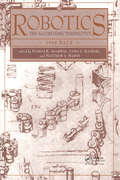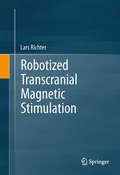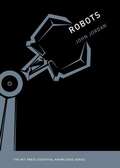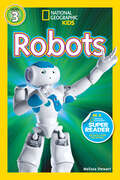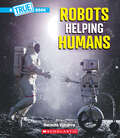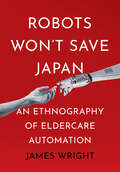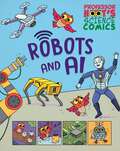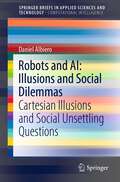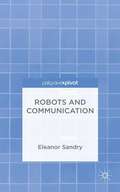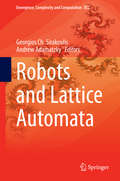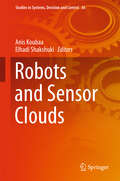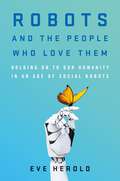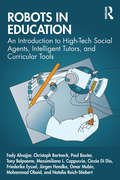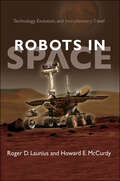- Table View
- List View
Robotics: WAFR 1998
by Ian MuehlenhausThis volume gathers together cutting-edge research from the Third Workshop on Algorithmic Foundations of Robotics and gives a solid overview of the state of the art in robot algorithms. The papers cover core problems in robotics, such as motion planning, sensor-based planning, manipulation, and assembly planning. They also examine the application o
Robotik in der Wirtschaftsinformatik (Edition HMD)
by Stefan Meinhardt Sara D’OnofrioMit diesem Buch führen die HerausgeberInnen den Begriff „Robotik“ in der Wirtschaftsinformatik ein. Darunter sind Lösungen zu verstehen, die den Menschen in seinen Aktivitäten unterstützt und bestehende Geschäftsprozesse durch Automatisierung optimiert. Dabei werden die Integration und Interaktion von Robotern in Informationssystemen sowie mit den Menschen adressiert und weniger die Konstruktion eines Roboters. Nebst den theoretischen Grundlagen widmet sich das Herausgeberwerk der Vielfalt verschiedener Anwendungsmöglichkeiten.Unterschiedliche Fallbeispiele geben Einblick in die Anwendung von Robotic Process Automation, Chatbots, Servicerobotern und weiteren Robotik-Lösungen und dessen Nutzenpotenziale. Das Werk richtet sich gleichermaßen an Studierende, Fachleute aller Fachrichtungen als auch den interessierten AnwenderInnen. Es hilft der Leserin und dem Leser, die Bedeutungsvielfalt des Begriffs Robotik in der Wirtschaftsinformatik zu verstehen und verschiedene Einsatzmöglichkeiten im eigenen Umfeld zu erkennen und zu bewerten.Der InhaltGrundlagenRobotic Process AutomationChatbotsServiceroboterWeitere AnwendungsfälleDie ZielgruppenCIO / CxO; Führungskräfte aus den Unternehmensbereichen, Unternehmens- und IT-BeraterInnen, ExpertInnen im Bereich Wirtschaftsinformatik, BWL und IT, interessierte AnwenderInnen, Studierende der WirtschaftsinformatikDas Herausgeber-Team Sara D'Onofrio ist IT Business Partner und Innovation Manager eines der größten Detailhandelsunternehmen der Schweiz, Autorin und Herausgeberin der Zeitschrift HMD Praxis der Wirtschaftsinformatik bei Springer und Gastdozentin an Hochschulen. Zu ihren ehrenamtlichen Tätigkeiten zählen ihr Engagement für die Stiftung FMsquare, die Unterstützung als Expertin beim Smart City Verein Bern sowie als Advisor beim NGO Spring A-C-T. Sie hat Betriebswirtschaft und Wirtschaftsinformatik studiert und in Informatik promoviert.Stefan Meinhardt ist SAP Mitarbeiter im Vorruhestand, wirkt aber weiterhin aktiv als Partner und Senior Advisor bei der dr. Fuchs Senior Advisors GmbH und berät SAP-Kunden und -Partner in strategischen Fragestellungen rund um die Themen: Digital Business Transformation, Business Model bzw. Process Innovations, Business Development, Sales & Consulting Management sowie IT Program and Project Management. Als VP und Bereichsleiter im SAP Sales sowie in der SAP Digital Business Service Organisation leitete er über viele Jahre die Beratungseinheiten für die Branchen Konsumgüter, Handel, Chemie, Pharma und Life Science sowie die Service-Industrien.
Robotization and Economic Development
by Siddhartha MitraThis book critically examines the sweeping impacts of robotization and the use of artificial intelligence on employment, per capita income, quality of life, poverty, and inequality in developing and developed economies. It analyzes the direct and indirect effects they have had and are projected to have on the labour markets and production processes in the manufacturing, healthcare and agricultural industries among others. The author explores comparisons of human labour with robotic labour emphasizing the changes that new technologies will bring to traditionally labour-intensive industries. Offering various insights into the effectiveness, benefits and negative implications of robotization on the economy, the book provides a comprehensive picture for policymakers to implement changes that embrace new technologies while meeting employment needs and development goals. Topical and lucid, this book will be an essential read for scholars and researchers of science and technology studies, digital humanities, economics, labour studies, public policy, development studies, political studies and sociology as well as policymakers and others who are interested in these areas.
Robotized Transcranial Magnetic Stimulation
by Lars RichterRobotized Transcranial Magnetic Stimulation describes the methods needed to develop a robotic system that is clinically applicable for the application of transcranial magnetic stimulation (TMS). Chapter 1 introduces the basic principles of TMS and discusses current developments towards robotized TMS. Part I (Chapters 2 and 3) systematically analyzes and clinically evaluates robotized TMS. More specifically, it presents the impact of head motion on the induced electric field. In Part II (Chapters 3 to 8), a new method for a robust robot/camera calibration, a sophisticated force-torque control with hand-assisted positioning, a novel FTA-sensor for system safety, and techniques for direct head tracking, are described and evaluated. Part III discusses these developments in the context of safety and clinical applicability of robotized TMS and presents future prospects of robotized TMS. Robotized Transcranial Magnetic Stimulation is intended for researchers as a guide for developing effective robotized TMS solutions. Professionals and practitioners may also find the book valuable.
Robots
by John M. JordanRobots are entering the mainstream. Technologies have advanced to the point of mass commercialization -- Roomba, for example -- and adoption by governments -- most notably, their use of drones. Meanwhile, these devices are being received by a public whose main sources of information about robots are the fantasies of popular culture. We know a lot about C-3PO and Robocop but not much about Atlas, Motoman, Kiva, or Beam--real-life robots that are reinventing warfare, the industrial workplace, and collaboration. In this book, technology analyst John Jordan offers an accessible and engaging introduction to robots and robotics, covering state-of-the-art applications, economic implications, and cultural context.Jordan chronicles the prehistory of robots and the treatment of robots in science fiction, movies, and television -- from the outsized influence of Mary Shelley's Frankenstein to Isaac Asimov's I, Robot (in which Asimov coined the term "robotics"). He offers a guided tour of robotics today, describing the components of robots, the complicating factors that make robotics so challenging, and such applications as driverless cars, unmanned warfare, and robots on the assembly line. Roboticists draw on such technical fields as power management, materials science, and artificial intelligence. Jordan points out, however, that robotics design decisions also embody such nontechnical elements as value judgments, professional aspirations, and ethical assumptions, and raise questions that involve law, belief, economics, education, public safety, and human identity. Robots will be neither our slaves nor our overlords; instead, they are rapidly becoming our close companions, working in partnership with us -- whether in a factory, on a highway, or as a prosthetic device. Given these profound changes to human work and life, Jordan argues that robotics is too important to be left solely to roboticists.
Robots (National Geographic Kids Readers)
by Melissa StewartDiscover the coolest robots of today and tomorrow in this colorful, photo-packed book. In this inviting and entertaining format, kids will learn about the science behind these amazing machines. This Level 3 reader is written in an easy-to-grasp style to encourage the scientists of tomorrow!National Geographic supports K-12 educators with ELA Common Core Resources.Visit www.natgeoed.org/commoncore for more information.
Robots Helping Humans (A True Book)
by Natasha VizcarraHow do robots help humans? Discover the latest advancements with this book for young readers.Robots have been helping humans for many years. You can probably spot a few robots at work right at home or in your own neighborhood. But did you know that robots also accomplish some of the most dangerous—and often icky—jobs people need to do? Robots are at work in the deepest oceans, inside of sewers, and even inside people’s bodies! Robots Helping Humans uses engaging, interactive text—including critical-thinking questions—to introduce readers to how robotics have changed our lives for the better.ABOUT THIS SERIES:The world of media and technology is changing fast-and young students are right there in the thick of it. As children try to make sense of new technologies, they face a variety of critical issues, including how to access reliable sources of information, how to protect themselves online, and how to use technology in mindful and respectful ways. That's where the books in the Our Digital Future series can help. Each title has been developed to help young readers think critically and navigate new technologies with confidence and care
Robots Unlimited: Life in a Virtual Age
by David LevyConsider this: Robots will one day be able to write poetry and prose so touching that it will make men weep; compose dozens or even hundreds of symphonies that will rival the work of Mozart; judge a court case with absolute impartiality and fairness; or even converse with the natural ease of your best friend. Robots will one day be so life-like tha
Robots Won't Save Japan: An Ethnography of Eldercare Automation (The Culture and Politics of Health Care Work)
by James WrightRobots Won't Save Japan addresses the Japanese government's efforts to develop care robots in response to the challenges of an aging population, rising demand for eldercare, and a critical shortage of care workers. Drawing on ethnographic research at key sites of Japanese robot development and implementation, James Wright reveals how such devices are likely to transform the practices, organization, meanings, and ethics of caregiving if implemented at scale. This new form of techno-welfare state that Japan is prototyping involves a reconfiguration of care that deskills and devalues care work and reduces opportunities for human social interaction and relationship building. Moreover, contrary to expectations that care robots will save labor and reduce health care expenditures, robots cost more money and require additional human labor to tend to the machines. As Wright shows, robots alone will not rescue Japan from its care crisis. The attempts to implement robot care instead point to the importance of looking beyond such techno-fixes to consider how to support rather than undermine the human times, spaces, and relationships necessary for sustainably cultivating good care.
Robots and AI (Professor Hoot's Science Comics #2)
by Minerva BlackEvery day brings a new adventure for Professor Hoot - and a new learning experience. A new student has joined the class, and it's distinctly robotic! What is it doing there? Professor Hoot decides to find out more about robots and AI... Discover robots that can tell how you feel, cars that drive themselves, and even robot explorers gathering data about other planets. There's more to these helpful machines than meets the eye, let's find out how they work.An entertaining comic strip approach to KS1 science topics, Professor Hoot's Science Comics are accessible and full of fun. Each book is an adventure and a chance for readers to learn something new, before testing their knowledge at the end of each book in Professor Hoot's quiz. Collect each adventure: Big Machines; Dangerous Animals; Dinosaurs; Robots and AI; Space; Volcanoes and Earthquakes.
Robots and AI: Cartesian Illusions and Social Unsettling Questions (SpringerBriefs in Applied Sciences and Technology)
by Daniel AlbieroThis book aims to critically assess the Cartesian stance that affirms robotic and AI technologies as candidates to supplant human capacities in non-routine intellectual nature activities based on social power relations. In the argumentation listed, the contradictions that this hypothesis approaches will be exposed, mainly in a historical and social analysis based on a complex and uncertain sociological perspective, added by a discussion within the scope of the Chaos theory. Finally, an outline of the current era, fostered by extremisms and extremists, will be described in terms of its contradictions in an attempt at sociological analysis. For this, some crucial and unsettling questions will be asked, and an effort to come up with answers will be made for some.
Robots and Communication
by Eleanor SandryThis book explores communication between humans and robots. Using a range of communication theories, it highlights how each theory provides a different perspective on the communication that occurs. The analysis of human interactions with a variety of forms of robot suggests new ways to perceive what communication, and being a communicator, entails.
Robots and Lattice Automata
by Georgios Ch. Sirakoulis Andrew AdamatzkyThe book gives a comprehensive overview of the state-of-the-art research and engineering in theory and application of Lattice Automata in design and control of autonomous Robots. Automata and robots share the same notional meaning. Automata (originated from the latinization of the Greek word "αυτματον") as self-operating autonomous machines invented from ancient years can be easily considered the first steps of robotic-like efforts. Automata are mathematical models of Robots and also they are integral parts of robotic control systems. A Lattice Automaton is a regular array or a collective of finite state machines, or automata. The Automata update their states by the same rules depending on states of their immediate neighbours. In the context of this book, Lattice Automata are used in developing modular reconfigurable robotic systems, path planning and map exploration for robots, as robot controllers, synchronisation of robot collectives, robot vision, parallel robotic actuators. All chapters are written in an accessible manner and lavishly illustrated. The book will help computer and robotic scientists and engineers to understand mechanisms of decentralised functioning of robotic collectives and to design future and emergent reconfigurable, parallel and distributed robotic systems.
Robots and Sensor Clouds
by Anis Koubaa Elhadi ShakshukiThis book comprises four chapters that address some of the latest research in clouds robotics and sensor clouds. The first part of the book includes two chapters on cloud robotics. The first chapter introduces a novel resource allocation framework for cloud robotics and proposes a Stackelberg game model and the corresponding task oriented pricing mechanism for resource allocation. In the second chapter, the authors apply Cloud Computing for building a Cloud-Based 3D Point Cloud extractor for stereo images. Their objective is to have a dynamically scalable and applicable to near real-time scenarios.
Robots and the People Who Love Them: Holding on to Our Humanity in an Age of Social Robots
by Eve HeroldThe latest developments in robotics and artificial intelligence and a preview of the coming decades, based on research and interviews with the world's foremost experts. If there’s one universal trait among humans, it’s our social nature. The craving to connect is universal, compelling, and frequently irresistible. This concept is central to Robots and the People Who Love Them. Socially interactive robots will soon transform friendship, work, home life, love, healthcare, warfare, education, and nearly every nook and cranny of modern life. This book is an exploration of how we, the most gregarious creatures in the food chain, could be changed by social robots. On the other hand, it considers how we will remain the same, and asks how human nature will express itself when confronted by a new class of beings created in our own image. Drawing upon recent research in the development of social robots, including how people react to them, how in our minds the boundaries between the real and the unreal are routinely blurred when we interact with them, and how their feigned emotions evoke our real ones, science writer Eve Herold takes readers through the gamut of what it will be like to live with social robots and still hold on to our humanity. This is the perfect book for anyone interested in the latest developments in social robots and the intersection of human nature and artificial intelligence and robotics, and what it means for our future.
Robots in Education: An Introduction to High-Tech Social Agents, Intelligent Tutors, and Curricular Tools
by Massimiliano Cappuccio Friederike Eyssel Paul Baxter Tony Belpaeme Christoph Bartneck Fady Alnajjar Cinzia Di Dio Jürgen Handke Omar Mubin Mohammad Obaid Natalia Reich-StiebertRobots in Education is an accessible introduction to the use of robotics in formal learning, encompassing pedagogical and psychological theories as well as implementation in curricula. Today, a variety of communities across education are increasingly using robots as general classroom tutors, tools in STEM projects, and subjects of study. This volume explores how the unique physical and social-interactive capabilities of educational robots can generate bonds with students while freeing instructors to focus on their individualized approaches to teaching and learning. Authored by a uniquely interdisciplinary team of scholars, the book covers the basics of robotics and their supporting technologies; attitudes toward and ethical implications of robots in learning; research methods relevant to extending our knowledge of the field; and more.
Robots in Space (Fountas & Pinnell LLI Purple #Level U)
by Kathleen Krull Paul BrewerA Solution in Space. Space travel is exciting--seeing what other planets look like, finding out about the origins of the universe, and creating brand-new technologies. But sending a manned mission out into deep space presents huge risks and obstacles. A solution is here: robots. They can take our place in space, and in fact, we've already sent robots to explore the planet Mars. Robots are probably the only way that earthlings will ever get to see what is out there--way, way out there!
Robots in Space: Technology, Evolution, and Interplanetary Travel (New Series in NASA History)
by Roger D. Launius Howard E. McCurdy2008 Outstanding Academic Title, Choice MagazineGiven the near incomprehensible enormity of the universe, it appears almost inevitable that humankind will one day find a planet that appears to be much like the Earth. This discovery will no doubt reignite the lure of interplanetary travel. Will we be up to the task? And, given our limited resources, biological constraints, and the general hostility of space, what shape should we expect such expeditions to take?In Robots in Space, Roger Launius and Howard McCurdy tackle these seemingly fanciful questions with rigorous scholarship and disciplined imagination, jumping comfortably among the worlds of rocketry, engineering, public policy, and science fantasy to expound upon the possibilities and improbabilities involved in trekking across the Milky Way and beyond. They survey the literature—fictional as well as academic studies; outline the progress of space programs in the United States and other nations; and assess the current state of affairs to offer a conclusion startling only to those who haven't spent time with Asimov, Heinlein, and Clarke: to traverse the cosmos, humans must embrace and entwine themselves with advanced robotic technologies.Their discussion is as entertaining as it is edifying and their assertions are as sound as they are fantastical. Rather than asking us to suspend disbelief, Robots in Space demands that we accept facts as they evolve.
Robots on the Farm: Independent Reading Orange 6 (Reading Champion #515)
by Katie WoolleyThis book is part of Reading Champion, a series carefully linked to book bands to encourage independent reading skills, developed with UCL Institute of Education (IOE)Robots on the Farm is a non-fiction text reporting on how robots are used in farming. The simple sentence structure offers readers the opportunity for an independent reading experience with the support of the illustrations.Reading Champion offers independent reading books for children to practise and reinforce their developing reading skills.This early non-fiction text is accompanied by engaging artwork and a reading activity. Each book has been carefully graded so that it can be matched to a child's reading ability, encouraging reading for pleasure.
Robots, Drones, UAVs and UGVs for Operation and Maintenance (ICT in Asset Management)
by Uday Kumar Diego Galar Dammika SeneviratneIndustrial assets (such as railway lines, roads, pipelines) are usually huge, span long distances, and can be divided into clusters or segments that provide different levels of functionality subject to different loads, degradations and environmental conditions, and their efficient management is necessary. The aim of the book is to give comprehensive understanding about the use of autonomous vehicles (context of robotics) for the utilization of inspection and maintenance activities in industrial asset management in different accessibility and hazard levels. The usability of deploying inspection vehicles in an autonomous manner is explained with the emphasis on integrating the total process. Key Features Aims for solutions for maintenance and inspection problems provided by robotics, drones, unmanned air vehicles and unmanned ground vehicles Discusses integration of autonomous vehicles for inspection and maintenance of industrial assets Covers the industrial approach to inspection needs and presents what is needed from the infrastructure end Presents the requirements for robot designers to design an autonomous inspection and maintenance system Includes practical case studies from industries
Robots, Robots Everywhere (Little Golden Book)
by Bob Staake Sue FliessOn the ground and in the air,/Robots, robots everywhere!Up in space, beneath the seas,/Robots make discoveries . . .So begins this rollicking Little Golden Book featuring robots of all kinds, from ones up in space to the ones we use at home. With bold, colorful artwork by award-winner Bob Staake, it's a perfect introduction to the fascinating subject of today's real robots!
Robots, Robots Everywhere: Read & Listen Edition (Little Golden Book)
by Sue FliessOn the ground and in the air,/Robots, robots everywhere!Up in space, beneath the seas,/Robots make discoveries . . .So begins this rollicking Little Golden Book featuring robots of all kinds, from ones up in space to the ones we use at home. With bold, colorful artwork by award-winner Bob Staake, it's a perfect introduction to the fascinating subject of today's real robots!This Read & Listen Edition contains audio narration.
Robots: Explore the World of Robots and How They Work for Us (Fact Atlas Series)
by Rick Allen LeiderRobots exist for so many different reasons. Many robots replace humans, whether it’s because a situation is dangerous or just tedious. There are rover robots to explore space and drone robots that play a part in our military today, but then there are also vacuum robots available for the average household’s chores. In Japan, there is a robot teacher that can mimic a wide range of human emotions--including anger at uncooperative students--thanks to eighteen small motors hidden beneath the latex skin covering her face. The Japanese government hopes to use robots to fill jobs left vacant by an anticipated labor shortage due to an aging population. In the United States, robots even help with surgery, allowing for incisions to be cut much smaller than they would be otherwise--meaning fewer complications and faster recovery times. This fascinating book in the Fact Atlas series explores the history of robots, from the very first robot designed by Leonardo da Vinci to predictions of the roles robots will play in our future. Kids will learn about how robots are often modeled after real life-forms, such as bees, sharks, and, of course, humans. Robots also takes into account the robots in pop culture--robots we have imagined could be a part of our future. Readers can decide for themselves whether or not they think robots should be developed to their fullest potential or kept in check by safety limitations.
Robots: From Science Fiction to Technological Revolution
by Daniel Ichbiah Ken KincaidIn this profusely illustrated work, journalist Ichbiah provides a broad view of the history, present, and future of robots, covering both the fictive and the real. Because of the scope of the material, little is treated in depth, but such is the trade off for discovering the amazing range of types of robots and the scope of their uses. Material ranges from the roots of the robot in the novel "Frankenstein" and other works to insect-like explorers designed to collect samples on mars, from simple childhood toys to advanced means of killing in wars, and from utilitarian automatic vacuum cleaners to whimsical art installations.
Robots: The Mit Press Essential Knowledge Series (The MIT Press Essential Knowledge series)
by John M. JordanAn accessible and engaging account of robots, covering the current state of the field, the fantasies of popular culture, and implications for life and work.Robots are entering the mainstream. Technologies have advanced to the point of mass commercialization—Roomba, for example—and adoption by governments—most notably, their use of drones. Meanwhile, these devices are being received by a public whose main sources of information about robots are the fantasies of popular culture. We know a lot about C-3PO and Robocop but not much about Atlas, Motoman, Kiva, or Beam—real-life robots that are reinventing warfare, the industrial workplace, and collaboration. In this book, technology analyst John Jordan offers an accessible and engaging introduction to robots and robotics, covering state-of-the-art applications, economic implications, and cultural context.Jordan chronicles the prehistory of robots and the treatment of robots in science fiction, movies, and television—from the outsized influence of Mary Shelley's Frankenstein to Isaac Asimov's I, Robot (in which Asimov coined the term “robotics”). He offers a guided tour of robotics today, describing the components of robots, the complicating factors that make robotics so challenging, and such applications as driverless cars, unmanned warfare, and robots on the assembly line. Roboticists draw on such technical fields as power management, materials science, and artificial intelligence. Jordan points out, however, that robotics design decisions also embody such nontechnical elements as value judgments, professional aspirations, and ethical assumptions, and raise questions that involve law, belief, economics, education, public safety, and human identity. Robots will be neither our slaves nor our overlords; instead, they are rapidly becoming our close companions, working in partnership with us—whether in a factory, on a highway, or as a prosthetic device. Given these profound changes to human work and life, Jordan argues that robotics is too important to be left solely to roboticists.
